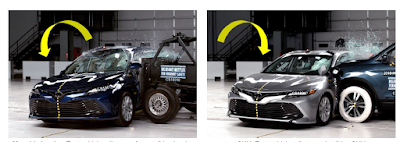
IIHS prepares to launch new, more challenging side crash test
The Insurance Institute for Highway Safety’s side crash test has led to lifesaving improvements in occupant protection since it was introduced in 2003.
There’s just one problem: The program has been so successful that the current side ratings no longer help consumers distinguish among vehicles or point the way toward further improvements.
An updated test should help. IIHS researchers and engineers have been weighing potential changes. A new test program with a higher impact speed and a heavier, more realistic movable barrier representing a more modern striking vehicle is expected to be launched next year.
In addition to identifying things that should change, the research has also clarified what aspects of the current evaluation work well.
Measures collected from the test were found to correlate closely with fatality risk.
Thus, the new test will likely use the same dummies and collect similar information as the current one.
“This is an opportunity to build on what we’ve learned in more than 15 years of side testing,” says IIHS Senior Research Engineer Becky Mueller.
“We’ll update the things that need updating, but we don’t need to throw out the things that still work well.”
Crash test history
When IIHS developed its current side crash test, it filled a need that had emerged with the rise in popularity of SUVs. At the time, the National Highway Traffic Safety Administration (NHTSA) was conducting side tests as part of its consumer information program, using a movable barrier with the height of a car.That test, still part of NHTSA’s ratings, doesn’t reflect the much greater risk of head injury from impacts with taller vehicles.
The IIHS test proved more challenging than the NHTSA test because the Institute’s movable barrier mimicked the height and shape of the front end of the typical SUV or pickup on the road at the time.
IIHS also used dummies representing a small woman or 12-year-old child. The combination of these two things meant that the barrier struck the vehicle at about the height of the dummies’ heads.
To achieve a good rating in the test, automakers strengthened side structures and equipped vehicles with head-protecting side airbags ahead of a federal regulation that made them essentially mandatory. Only about 1 in 5 vehicles tested earned good ratings in the beginning.
Today, 99 percent of rated vehicles earn a good rating, and the remainder are acceptable.
NHTSA barrier, shown in yellow, superimposed over the taller IIHS barrier










